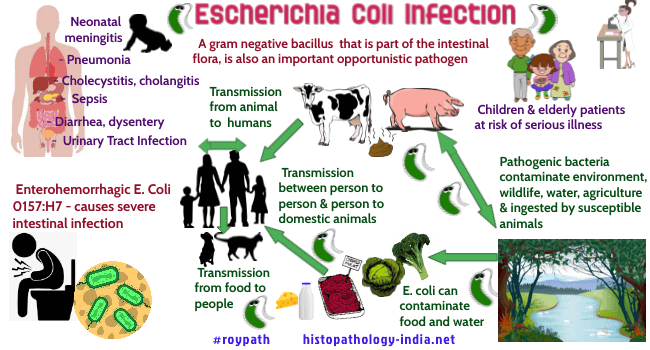|

Custom Search
|
|
Infectious Disease Online Pathology of Escherichia Coli Infection
|

|
Escherichia coli, a gram-negative bacillus that is part of the intestinal flora, is also an important opportunistic pathogen, causing diarrhea and dysentery, cholecystitis, bacteremia, cholangitis, urinary tract infection, pneumonia and neonatal meningitis. Escherichia coli causes various patterns of human enteric diseases caused by different varieties of Escherichia coli. Some of these are - Enterotoxigenic ; Enteroinvasive ; Enteroadherent ; Enterohemorrhagic. Enterotoxigenic Escherichia coli causes diarrheal disease by elaborating two plasmid-mediated enterotoxins. The heat-labile toxin is antigenically, structurally and functionally related to the cholera toxin, although the toxin of Escherichia coli is less potent than that of cholera. The heat-labile toxin also binds to DM1 ganglioside on the intestinal epithelial cells. As in cholera, resulting activation of adenyl cyclase produces a hypersecretory diarrhea. The heat-stable toxin of Escherichia coli is different from cholera toxin and apparently acts to impair sodium and chloride absorption and to reduce the motility of small intestine through a mechanism dependent on cyclic GMP. Dehydration and electrolyte imbalance is a significant cause of morbidity and mortality when appropriate rehydration is lacking. Enterotoxigenic Escherichia coli is also responsible for 50% of traveller’s diarrhea. Enteroinvasive Escherichia coli produces a dysentery-like disease resembling shigellosis, although it is less severe and requires a much larger infecting dose of organisms. Enteroinvasive Escherichia coli invades the intestinal mucosa and causes local tissue destruction and sloughing of necrotic mucosa. Bloody mucoid stools contain neutrophils. Enteroadhesive Escherichia coli has been associated with diarrheal diseases. Enteroadhesiveness is plasmid-dependent and is apparently mediated by pili, which bind tightly to receptors of the intestinal epithelial cells. The mechanism of diarrhea is unknown.
The most common strain of enterohemorrhagic Escherichia coli is 0157:H7. It is one of the Shiga-like toxin–producing types of E.coli (STEC). This organism adheres to intestinal epithelial cells and produces a cytotoxin similar to that produced by Shigella dysenteriae. Shiga toxin-producing Escherichia coli (STEC) is a global foodborne bacterial pathogen that is often accountable for colon disorder or distress. STEC commonly induces severe diarrhea in hosts but can cause critical illnesses due to the Shiga toxin virulence factors. Contaminated meat is the most frequent mode of transmission, but infection may also occur through contaminated water, milk, produce, and person-to-person contact. The symptoms include bloody diarrhea with severe abdominal cramps and mild or no fever. Non bloody, watery diarrhea may occur. Some patients have fecal leukocytes. Patients are at risk for the hemolytic-uremic syndrome or thrombotic thrombocytopenic purpura. Children and elderly patients are at particular risk of serious illness. Patients may have colonic edema, erosions, ulcers, and hemorrhage, and the right colon is usually more severely affected. The lamina propria and submucosa contain marked edema and hemorrhage, with associated mucosal acute inflammation, cryptitis, crypt abscesses, ulceration, and necrosis. Microthrombi may be seen within small vessels, and pseudomembranes are occasionally present. About 80% of all infections of the urinary tract in humans, ranging from mild cystitis to fatal pyelonephritis, are caused by Escherichia coli. In addition, Escherichia coli is the etiologic agent in many cases of nosocomial pneumonia, most often in elderly patients with underlying chronic disease. Aspirates of endogenous oral flora containing Escherichia coli appear to be the cause of this bronchopneumonia,although in bacteremic patients pneumonia may result from seeding by septic emboli. Empyema is a common complication, especially in patients with disease lasting more than a week. Only rarely does Escherichia coli cause meningitis in adults, but it is a major cause of neonatal meningitis. Between 40% and 80% of infants with Escherichia coli meningitis die, and the survivors frequently suffer from neurologic or developmental anomalies.
|
|
|
Copyright © 2022 histopathology-india.net

